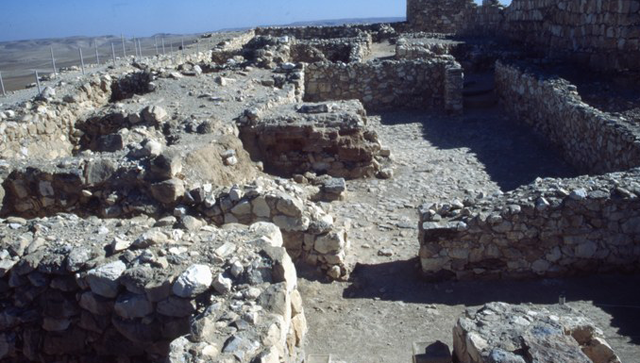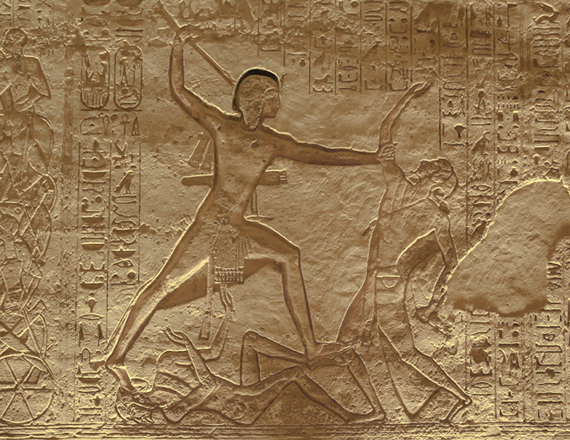You are here
Bronze Age warfare: insights from archaeological, textual evidence
By Saeb Rawashdeh - Aug 21,2024 - Last updated at Aug 21,2024

The temple in the Upper Fortress at Tel Arad (Photo courtesy of ACOR)
AMMAN — The study of the ancient warfare is often connected with study of available weaponry and fortifications recovered by archaeologists. Researchers specialised in the Bronze Age Levant had to take into account military technology and administrative records of Egypt and Mesopotamia because these centres had the greatest impact on the territory of Levant and its warfare.
Such evidence included artefacts and iconographic and textual records seen in Egyptian tomb paintings and Mesopotamian stelae, while written sources provide detailed information about military tactics and strategy. Also fortresses, uncovered by scientific teams, offer an insight in development of protection of towns and its population. Here, we are focused on a period between 2,500 BC and 1,500 BC in Levant.
"By considering the most frequently attested weapons employed in siege warfare it is possible to assess the function and effectiveness of these weapons. Mortuary evidence likewise supports not only the conclusion that siege warfare had become the dominant mode of warfare during this period, but also poignantly illustrates how these weapons were employed," noted the professor of Archaeology Aaron Burke from The University of California Los Angeles, adding that through these diverse lines of inquiry, it is possible to assess the role played by the development of weaponry in the evolution of warfare in the Levant from the period of the Ebla empire through the expulsion of the Hyksos.
Textual evidence deals with the destruction of Ur by the Elamites in 1,911 BC and the massacre that followed. Most of the remaining textual sources from Mesopotamia are of a historical or commemorative nature, and thus for the Middle Bronze Age this remains our only detailed “eye witness” account of the downfall of a major city following a siege.
Typical weapons for the Middle Bronze age are a dagger, battle-axe, spear or javelin.
Different champions of warring parties were also mentioned in textual sources and we also have accounts of siege engineering techniques.
"The Kirta Epic illustrates a number of details regarding siege warfare: ‘Like grasshoppers, you will invade the field, like locusts the edges of the steppe-land. Go a day, a second, a third, a fourth day, a fifth, a sixth day… The women gathering wood will flee from the fields, from the threshing-floors the women gathering straw; The women drawing water will flee from the spring, from the fountain the women filling (jugs)…. Do not shoot your arrows at the city, your sling-stones at the towers.'"
"From this passage several observations regarding Bronze Age warfare can be made. First, it illustrates that during the mid-second millennium long-distance campaigns remained as common as they had been during the first half of the second millennium. Second, it confirms that a region’s inhabitants routinely fled from unfortified settlements in the countryside to walled towns for refuge during an invasion. Third, it reveals at the least an occasional adherence to a strategy of prolonged siege —without a direct assault— with the intention of wearing down those besieged. Finally, it also provides a glimpse into the real discomforts that siege warfare inflicted on a population [and their animals]," Burke elaborated.
Thus, in addition to Bronze Age Mesopotamian traditions, Levantine traditions from the Late Bronze Age also provide a vivid depiction of warfare during the
second millennium, the scholar said, adding that comparisons between ancient Near Eastern literary traditions that relate to the art of warfare, however limited they are, and literary traditions from other regions of the ancient world suggest that fundamental similarities in the nature of warfare can be identified between the Bronze Age Near East and slightly later periods in other regions.
These additional sources are useful for the light they can shed on details related to Bronze Age warfare in the Near East, which are not made explicit in the limited sources available.
According to a well-known Chinese scholar and master tactician Sun Tzu, during the Warring States Period (ca. 450–300 BC), China experienced tactical concerns that were comparable to those of the pre-classical Near East.
"Observations include that the chariot was common in open battles, the composite bow dominated engagements, siege techniques were virtually identical [and lacked machinery], and cavalry had not yet been introduced. In light of our understanding of warfare as waged by Near Eastern powers during the Bronze and Iron Ages and in the absence of such Near Eastern treatises, Sun Tzu’s statements uniquely illustrate the nature of the art of war during the Bronze Age," Burke said, adding that a specific nature of ancient Near Eastern siege warfare has often been usefully illuminated by classical authors.
Related Articles
AMMAN – Chariots played a prominent role in traditions for different civilisations.
AMMAN — With the development of the first civilisations, the weaponry also improved and some of most popular weapons in the Bronze Age were
AMMAN – There are two types of weapons in the Bronze Age warfare: ceremonial weapons of rulers and members of the political elites, and weap














